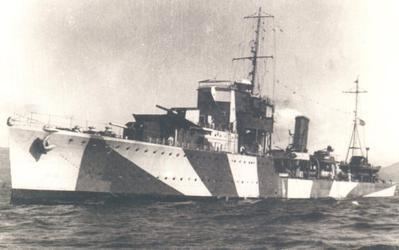Namesake Queen Olga Commissioned 4 February 1939 Fate sunk 26 September 1943 Launched 2 June 1938 Beam 9.7 m | Laid down 1 February 1937 Identification D15 Construction started 1 February 1937 Length 98 m Builder Yarrow Shipbuilders | |
 | ||
Name Vasilissa Olga
ΒΠ Βασίλισσα Όλγα | ||
Greek destroyer vasilissa olga d15
Vasilissa Olga (Greek: ΒΠ Βασίλισσα Όλγα) was a Greek destroyer of the Vasilefs Georgios (modified G) class, which served with the Royal Hellenic Navy during the Second World War, becoming its most distinguished and successful ship until her loss in 1943. She was named after Queen Olga of Greece, the wife of King George I, and was the second ship to bear this name.
Contents
Built by Yarrow & Company (Scotstoun, Scotland), along with her sister ship, Vasilefs Georgios, she was the most modern ship of the Greek Navy at the outbreak of the Second World War.
Service history
She participated in the naval operations of the Greco-Italian War, in convoy escort duty and in the first and third naval raids against Italian shipping in the Strait of Otranto (14–15 November 1940, and 4–5 January 1941).
After the German invasion of Greece, along with several other ships, she escaped to Alexandria in May 1941. She was assigned the British pennant number H 84, and after undergoing modernization in Calcutta (November–December 1941), she returned to active duty in the Mediterranean Sea. Under her captain, Lt. Cmdr. G. Blessas, she enjoyed several successes.
On 14 December 1942, she, along with the British destroyer HMS Petard, sank the Italian Adua-class submarine Uarsciek (620 tons) off Malta. The following month, on 19 January 1943, Vasilissa Olga, along with British destroyers HMS Pakenham and HMS Nubian, intercepted and sank the Italian transport ship Stromboli (475 tons) off the Libyan coast.
On June 2, 1943, Vasilissa Olga and the British destroyer HMS Jervis engaged an Italian convoy and sank its lone escort, the Spica-class torpedo boat Castore (ca. 790 tons), off Cape Spartivento. The convoy, made of two Italian freighters, managed to escape.
Vasilissa Olga also participated in the capture of Pantelleria and the Allied invasion of Sicily. During the Allied operations during the Dodecanese Campaign in the Aegean Sea in September 1943, together with the British destroyers HMS Faulknor and Eclipse, she sank a German convoy, consisting of the transports Pluto (2,000 tons) and Paolo (4,000 tons), near Astypalea. During the Battle of Leros, Vasilissa Olga transported members of the Long Range Desert Group to the island, but on 26 September, she was attacked and sunk by 25 Junkers Ju 88 bombers in the Gulf of Lakki in Leros. Commodore Blessas, 6 officers and 65 other members of the crew perished with the ship. A monument has been erected in Lakki in honour of the ship.
